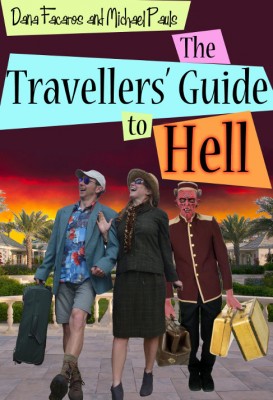The Travellers’ Guide to Hell, by Dana Facaros and Michael Pauls
By Tom JonesNo one, it seems, has done a guidebook to this popular destination since a fellow named Dante 700 years ago. So Dana Facaros and Michael Pauls, authors of over thirty guidebooks to more mundane places like Italy, Greece and France (for Cadogan Guides and others) thought they would give it a try.
 “The Travellers’ Guide to Hell” is a wild ride, an avalanche of quirky illustrations, dodgy jokes and diabolically bad puns, but there’s definitely a method in the learned authors’ madness. Out of thousands of years of Hellish history, spanning cultures and religions around the globe, they’ve done their best to get to the bottom of just what makes people dream of Devils and demons and underworld torments.
“The Travellers’ Guide to Hell” is a wild ride, an avalanche of quirky illustrations, dodgy jokes and diabolically bad puns, but there’s definitely a method in the learned authors’ madness. Out of thousands of years of Hellish history, spanning cultures and religions around the globe, they’ve done their best to get to the bottom of just what makes people dream of Devils and demons and underworld torments.
Did you know the first boss of Hell was a woman? Her name was Ereshkigal, back in ancient Mesopotamia. Or that there’s a box in a Paris church where you can leave messages for souls in Purgatory? Or that the Devil occasionally gives press conferences? (The last one was in Warsaw, in 1963.) You’ll learn a lot about the Devil—like why he hasn’t got a bum. There’s another face there instead, with 20,000 monks stuffed in it.
Being a parody guide after all, the practical information is thoroughly covered in “The Travellers’ Guide to Hell.” It’s all here: Getting There, What to Pack and What to Eat, gossip reports on all the top demons and even day trips to Limbo and Purgatory. There’s a fascinating section on Entertainment. The Devil himself—a mean fiddler they say—used to provide that, but according to the guide the prevalent sound down there seems to be Norwegian Death Metal.
In case you’re not familiar:
Aficionados define Death Metal as ‘the science of incorporating nihilistic brutality and frustrated anger of modern life into an art form of sound’. Notable groups include Slayer, Morbid Angel, Pestilence, Sepultura and the ever-popular Kataklysm.
But if Deathheads rule down below, it seems they might be going out of style back in Norway, at least ever since ‘KFC invented a fake Metal band to do ads for their Spicy Chicken’. Satanist Monkees—who wouldn’t buy a ticket for that?
For those who want to get to Hell in a hurry, there’s a whole section on the Seven Deadly Sins, and how to commit them. We think of the Seven Deadlies as something medieval, but the authors show us they never really went away. You could find them all, for example, on Gilligan’s Island:
Sherwood Schwarz, the show’s producer, only admitted years later that a parable on the Sins was exactly what he had in mind. For those who remember the show (94.3% of American baby-boomers), the Skipper represented Wrath, and as for the rest: the Professor (Pride), Ginger (Lust), Mary Ann (Envy), Thurston Howell III (Greed) Mrs. Howell (Gluttony), and Gilligan himself (Sloth). An alternative interpretation has the friendly but clueless Gilligan, who always wears red and fouls up every rescue attempt, as the Devil himself.
These days even whole nations are graded on the Sins. The 2010 international ratings (supplied by the BBC) found Australians on top for Envy, South Africans for Wrath, and Iceland winning both Sloth and Pride. Americans had to be content with being champs in Gluttony:
Gluttony charged back into Top Sin Status with the near-simultaneous invention of three-speed tractors, cheese-corn twisties, high-fructose corn syrup, corn dogs, caramel corn, corn-fed feedlot cattle, triple-dip ice-cream cones and above all that relentless and irresistible seducer of nations, the potato chip.
For an impressionable young country that grew up strong and mean on three meals a day fried in bacon fat, kept in a can by the side of the stove, the slippery slide into the searing skillet of sin was only too easy. Today, though a clearly embarrassed America has officially renounced the traditional fats, it’s still in the trough with all four hooves for everything else. Other nations we could mention are not far behind.
The best part of “The Travellers’ Guide to Hell” may be the tour of Hell by Odus Lee Wiggins, an Oklahoma preacher who started having visions when he was trying to fix his exhaust with a tomato can and his car fell on him. Rev. Wiggins gives a full report on what’s new in the Inferno since Dante passed through—for one thing, it’s a smoke-free zone now. We learn what happens to electric guitar players, the Swiss, abstract impressionists and U.S. congressmen, and meet some celebrity guests.
There’s more to this book than meets the eye. The authors have some fun with fundamentalists of course, and they turn their attention to the silly but dangerous Satanism scare of the 90’s, in which this sophisticated modern world of ours started to look a lot like the Middle Ages. The biggest surprise they reveal, though, is that God never sends anybody to Hell. Who says so? The pope, that’s who. John Paul II explained back in 1999 that by the time you die, you’ve already made your mind up where you want to go.
If you suspect you might be one of them, “The Travellers’ Guide to Hell” is definitely the book for you.
- Winning the Oscar by a Nose? - February 18, 2025
- Has Your Country Been Seized by a Tech Billionaire? What to Do During a Coup - February 11, 2025
- Trump to Deport Errant Golf Balls - February 4, 2025

